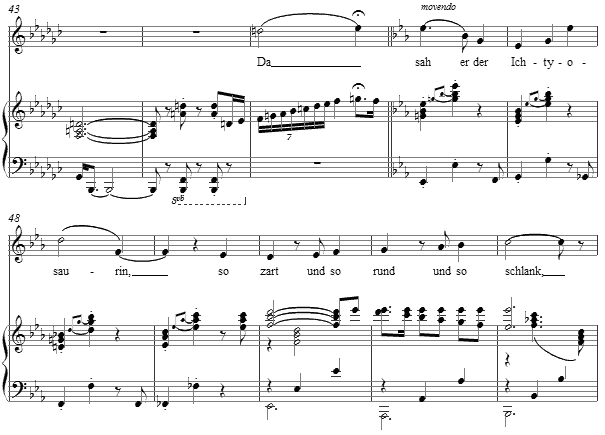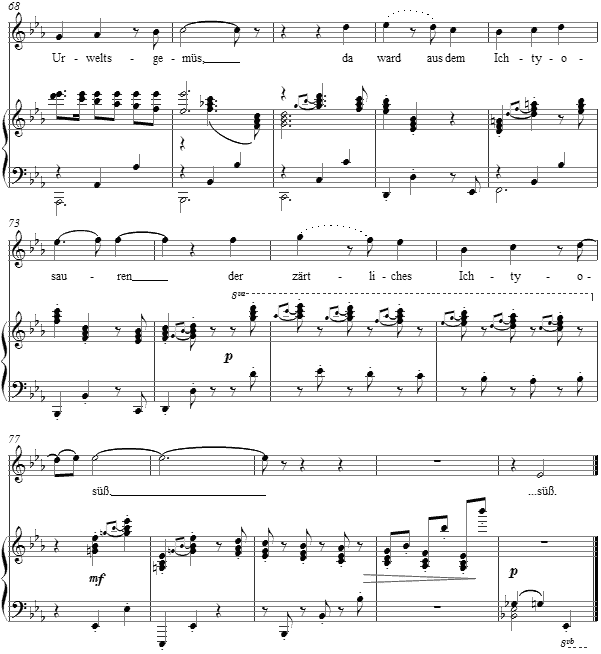Music and Texts of GARY BACHLUND
Vocal Music | Piano | Organ | Chamber Music | Orchestral | Articles and Commentary | Poems and Stories | Miscellany | FAQs
Prähistorische Ballade - (2009)
Friedrich Theodor Vischer
for high voice and piano
Ein Ichthyosaur sich wälzte
Am schlammigen, mulstrigen Sumpf.
Ihm war in der Tiefe der Seele
So säuerlich, saurisch und dumpf,
So dämlich, so zäh und so tranig,
So schwer und so bleiern und stumpf;
Er stürzte sich in das Moorbad
Mit platschendem, tappigem Pflumpf.
Da sah er der Ichthyosaurin,
So zart und so rund und so schlank,
Ins schmachtende Eidechsenauge,
Da ward er vor Liebe so krank.
Da zog es ihn hin zu der Holden
Durchs klebrige Urweltgemüs,
Da ward aus dem Ichthyosauren
Der zärtlichste Ichthyosüß.[ 4 pages, circa 2' 30" ]
Friedrich Theodor Vischer
A Ichthyosaur [ 1 ] did slowly roll
In his muddy, most foul-smelling fen.
Deep in the depths of his Ichtyo-soul
He was sour, Mesozoic, and then
He was stupid, and tough and so sluggish,
So heavy and leaden and plump;
He flailed in the mud like a Ichthyo-fish
With a splashing and smashing thud-thump.
Ah! he saw nearby Miss Ichthyosaur,
So slender and tender and round,
With his languishing lizards' eyes he swore
Ichthyo-love, for her he had found.
Then he waddled up near to this beauty,
As through the primeval ooze he did shove,
And there Ichthyosaur and his cutie
Made gentle Ichthyosaurian love.
(rhymed paraphrase by the composer)
Friedrich Theodor Vischer (1807 -1887) was a German academic and writer on aesthetics and the philosophy of art, as well as a minor poet. A friend of Möricke and Uhland, he was educated in Tübingen in the disciplines of theology, philosophy und philology. Advancing early in his career to a full professorship, his outspoken support for democratic movements put him at odds with local governments, and he spent therefore in various cities and positions prior to his home inviting him back toward the end of his life. His large work was the multi-volume Aesthetic, or the Science of Beauty (1846-1857). The text was written in 1867 and comes from a later collection, F. T. V.: Allotria, Stuttgart: Bonz & Co., 1909, additionally being reprinted in the modern Reclam series, Deutsche Unsinnpoesie.
This nonsense was a delight in the period in which Vischer worked, as other German poets also added to the fund of humor. In this case, the picture of the Ichthyosaur is truly nonsense, as it was based on rudimentary discoveries of that time. To contrast the silly "alpha and omega" of this poem, it begins in a dense E flat minor, as the harmonic progressions move often chromatically. It is a gentle waltz, a pun on the similar verbs "wälzen" and "walzen." ( To waltz as opposed to roll about, though I imagine some dancers lean towards the second verb at times.) The break in the words' vocal line is meant to over-dramatize this strange yet savory picture.
As with much of common practice standards, the use of minor giving way to major follows the "doctrine of affections" which falsely suggests a parallel between dark and light, or happy and sad. Yet, the text is of that period in which this would have been most appropriate. I mark the score movendo as the notion of love crosses t our dull protagonist's thoughts. The patterns are quite similar to the E flat minor, with modification for the harmonic needs of the overall progression.
The image of two prehistoric creatures being "sweet" as Vischer writes is itself amusing. For this the highest range of the piano tinkles it message that this love making was "zärtlich." Sweet, as the song ends with the last syllable of Vischer's inventive pen.
The score for Prähistorische Ballade is available as a free PDF download, though any major commercial performance or recording of the work is prohibited without prior arrangement with the composer. Click on the graphic below for this piano-vocal score.
NOTES
[ 1 ] In 1867, the idea of prehistoric creatures in general was novel, especially so with the Ichthyosauria or Ichthyopterygia
or "fish flippers" - a designation introduced by Sir Richard Owen in 1840.
Ichthyosaurus was the first complete fossil to be discovered in the early 1800's by Mary Anning in England. It was therefore quite the leading edge in science to be involved in such studies, and romanticized by the media of the day as well.
Vischer is therefore understandably misinformed about what became known of this species; they were "giant" marine reptiles that resembled fish and dolphins. The representation pictured here comes from a 1916 series of German collector cards titled, Tiere der Urwelt.
Early in the theorizing about this species it was believed that they were aquatic creatures who came onto land to breed and bear their offspring, which perhaps explains Vischer's delightful image of the "nuptial bed" of two such creatures.



